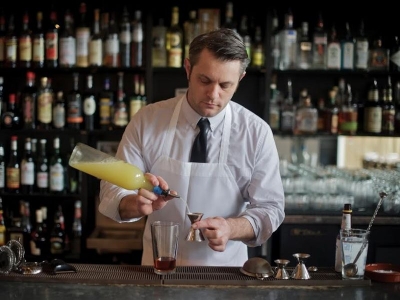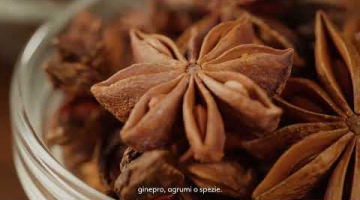The man who invented barrel-aging cocktails is now reviving "bad" drinks from the '80s.
Bartender Jeffrey Morgenthaler’s favorite spot to stand while building cocktails at Clyde Common in Portland's Ace Hotel is in front of the tavern's large window. One wonders if—as he looks out onto Stark Street contemplatively stirring a cocktail—he’s dreaming up the next big thing.
For those unfamiliar with Morgenthaler, he's the man responsible for whipping the bar world into a frenzy over barrel-aged cocktails in 2010 and bottled cocktail sodas a year later. But his most recent contribution, craft versions of "bad" cocktails, has brought back the ‘80s, a dark age for drinks. Those who have tasted his Amaretto Sour at Pépé Le Moko, his newest bar in the Ace, know he was the man to do it.
Pépé Le Moko's Amaretto Sour/Photo by Caroline Pardilla
Morgenthaler has been behind the stick full-time for the past 19 years, a rare thing now in a business where bartenders are quickly leaving the bar for plusher gigs as brand ambassadors for liquor companies. But dedication is not the only attribute that differentiates Morgenthaler from most every drink maker. Not only is he tattoo-free ("I like to be weird like that"), but his bar program at Clyde Common was nominated for a James Beard award three times and his cocktail book, The Bar Book, has been lauded by everyone from Pok Pok’s Andy Ricker to the Wall Street Journal.
How does he continue to innovate in an increasingly crowded industry? But more importantly, why bring back the Long Island Iced Tea? Morgenthaler answers below:
Where was your first solo cocktail program? It was called Bamboo, and it was in Eugene, Oregon. Sadly it’s no longer there. But it’s where I first managed, had my own cocktail list, used fresh juices and made (pretty terrible) syrups and stuff. Lots of infused vodkas. Like, lots of them.
But as far as drinks that are on my list, I’m lazy and selfish, so I just sell the sorts of drinks that I enjoy drinking myself.
How many cocktail programs have you worked on and where? Oh god. After Bamboo came Red Agave, a Nuevo Latino restaurant. Then I ran the list at Marché, a really kick-ass French restaurant that’s still killing it to this day. Then there was El Vaquero, a sort of Latin steakhouse and tapas bar. Then Bel Ami. These were all in Eugene. And in 2009 I moved up to Portland to take over the bar at Clyde Common. I’ve been there ever since, and now we have a second bar, Pépé Le Moko, in the basement.
How would you describe your style? I mean, I just tailor my style to the sort of place that I’m working in. Whatever the bar or restaurant needs me to be, I am. They’ve all been so different from one another. But as far as drinks that are on my list, I’m lazy and selfish, so I just sell the sorts of drinks that I enjoy drinking myself.
In creating a cocktail menu, how does your process start? Well, if it’s from scratch, it’s kind of dictated by the vision of the bar or restaurant. You know what I hate? When you go into like a hot new Mexican restaurant that’s doing all this amazing food, and the bar is putting out, like, spirit-driven gin cocktails. What are you doing over there, just jerking off? Right off the bat you should have like four different kinds of Margarita. Get with the program. So I listen to what the bar needs to be and build it around that.
... food is where it’s at. I get a lot of ideas from watching cooking shows or reading about food.
What inspires you? Chefs inspire me. I know that sounds pretty lame, but if I wasn’t doing this I’d be a line cook. I love food, I cook all the time at home. So when I go out to a new place, there’s always this awkward moment, where I’m super excited to check out all of the dishes, but the bar manager wants me to try the entire cocktail list. I’m like, "Nah, I’ll just have a glass of wine and a bottle of soda water." But seriously, food is where it’s at. I get a lot of ideas from watching cooking shows or reading about food.
What does your research for a cocktail program involve? I like to take a look at some lists around the world to see what they’re doing in other countries. You can always look at what Alex Kratena [in London] is doing, or Giuseppe Gonzalez [in New York], or some of those big names, and try to steal ideas. Otherwise, I think you just get stuck in your own head and start thinking it’s a good idea to put a Fernet Flip on the menu at a Japanese restaurant.
Clyde Common's Sophomore Slump and Pépé Le Moko's Grasshopper/Photos by Caroline Pardilla
Do you usually use books when building a cocktail program? I’ve got a pretty big library of books that I go through. Some of them are old friends, like Paul Harrington’s book or Jim Meehan’s. I’ll flip through those to see if there’s anything I’ve forgotten about that I want to do again. You’re like, oh shit, I totally forgot about the Frisco! And then I like to peruse my older books, but with those classic books—and nobody really talks about this—there are so many more crappy drinks to sort through in those old texts. I'll spend a week trying to get some obscure drink from the Savoy to balance, and in the end I have to scrap it. There’s a reason why drinks like the Manhattan and Negroni are still so popular. They’re really good.
You've invented many a cocktail trend, a mean feat especially now in this growing industry. How do you stay ahead of the curve? Yeah, it’s kind of funny, isn’t it? So much pressure sometimes. Honestly, I think that "staying ahead of the curve" implies some level of competition to me. I don’t really do this stuff to compete with anyone. And some people get that, some don’t. I really just do these things and then share them with the world because I want to help; especially those people in smaller markets. I remember very well what it was like being a bartender in a small town, and there was nobody local who could help me. So if I can teach some folks how to make their own ginger beer, or barrel-age a cocktail, or build a carbonation system, or whatever, just some basic techniques, then I’m super happy. But really, I just genuinely enjoy this stuff, so I’m thinking about it all the time. It also helps that I’m actually behind the bar four or five nights a week.
... our philosophy from the beginning was, "There are no bad drinks, only bad bartenders."
Why bring back "not-good" cocktails? Yeah, that wasn’t really our point with Pépé Le Moko. We were all so tired of these new bars where there would be some mixologist standing there telling you what you could or could not drink. It was starting to feel like bars were turning into record stores, but with shittier music. So our philosophy from the beginning was, "There are no bad drinks, only bad bartenders." We love Mojitos, and we make the best one in the city. Nobody rolls their eyes at Pépé when you order one. We love Long Islands, and Sazeracs, and Grasshoppers, and Oaxacan Old Fashioneds, and Amaretto Sours, and so on and so on. We just love drinks there, we don’t really care if someone else thinks they’re cool or not.
What is the secret to making a cocktail with a bad reputation a good one? Well, the bones have to be in place. It can’t just be bad, it has to have some redeeming qualities. Like, I’m never going to be able to make anything with Red Bull good. But then I just like to sorta dissect the drink and apply all that I’ve learned about making classic cocktails to that drink. The Amaretto Sour is a perfect example; the "classic" recipe is just amaretto and sour mix. But using a few tricks like high-proof bourbon, fresh lemon juice, and a little egg white, suddenly you have this super good drink.
thanks to: http://www.eater.com/drinks/2015/5/7/8561701/jeffrey-morgenthaler
















